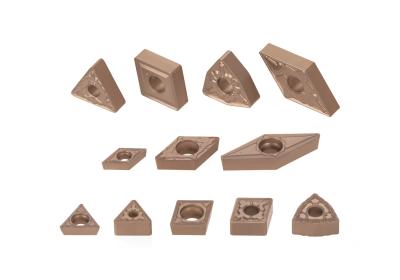
Tungaloy is expanding its T9200 CVD grade insert series to include T9205 and T9235 grades as well as the -TSF and -TM style chipbreakers to conquer steel turning markets. Both T9205 and T9235 are designed to provide outstanding wear resistance in the P05 and P35 application ranges surpassing existing CVD grades.
These capabilities are possible due to Tungaloy’s latest and most innovative coating technologies, including:
Extremely wear-resistant Al2O3 coating in a thick and uniformly aligned layer
Ultrahard ceramics for the outermost layer
PremiumTec – Tungaloy’s exclusive post surface treatment technology
T9205 and T9235 provide long and stable tool life in various steel turning applications, allowing customers to achieve high productivity. Combined with the -TSF and -TM style chipbreakers, the latest line of the T9200 series can now meet the needs in a wider spectrum of steel turning applications. This expansion complements the preceding T9215 and T9225 grades of the T9200 series addressing customers’ needs for high efficiency and high productivity machining. A total of 531 inserts are added in this expansion.
T9205 and T9235 at a glance:
Thick and uniformly aligned alumina layer of the coating provides superior wear resistance
Ultrahard ceramic layer that is 1.5x as hard as that of existing grades improves wear resistance
PremiumTec - post surface treatment technology for machining stability
TSF and TM style chipbreakers at a glance:
TSF: Provides excellent chip control at high feed rates, reducing entanglement and chatter
TM: Universal chipbreaker for various applications ranging from high-speed and -feed turning to varying depths of cut
Contact Details
Related Glossary Terms
- ceramics
ceramics
Cutting tool materials based on aluminum oxide and silicon nitride. Ceramic tools can withstand higher cutting speeds than cemented carbide tools when machining hardened steels, cast irons and high-temperature alloys.
- chatter
chatter
Condition of vibration involving the machine, workpiece and cutting tool. Once this condition arises, it is often self-sustaining until the problem is corrected. Chatter can be identified when lines or grooves appear at regular intervals in the workpiece. These lines or grooves are caused by the teeth of the cutter as they vibrate in and out of the workpiece and their spacing depends on the frequency of vibration.
- chemical vapor deposition ( CVD)
chemical vapor deposition ( CVD)
High-temperature (1,000° C or higher), atmosphere-controlled process in which a chemical reaction is induced for the purpose of depositing a coating 2µm to 12µm thick on a tool’s surface. See coated tools; PVD, physical vapor deposition.
- chipbreaker
chipbreaker
Groove or other tool geometry that breaks chips into small fragments as they come off the workpiece. Designed to prevent chips from becoming so long that they are difficult to control, catch in turning parts and cause safety problems.
- feed
feed
Rate of change of position of the tool as a whole, relative to the workpiece while cutting.
- turning
turning
Workpiece is held in a chuck, mounted on a face plate or secured between centers and rotated while a cutting tool, normally a single-point tool, is fed into it along its periphery or across its end or face. Takes the form of straight turning (cutting along the periphery of the workpiece); taper turning (creating a taper); step turning (turning different-size diameters on the same work); chamfering (beveling an edge or shoulder); facing (cutting on an end); turning threads (usually external but can be internal); roughing (high-volume metal removal); and finishing (final light cuts). Performed on lathes, turning centers, chucking machines, automatic screw machines and similar machines.
- wear resistance
wear resistance
Ability of the tool to withstand stresses that cause it to wear during cutting; an attribute linked to alloy composition, base material, thermal conditions, type of tooling and operation and other variables.

